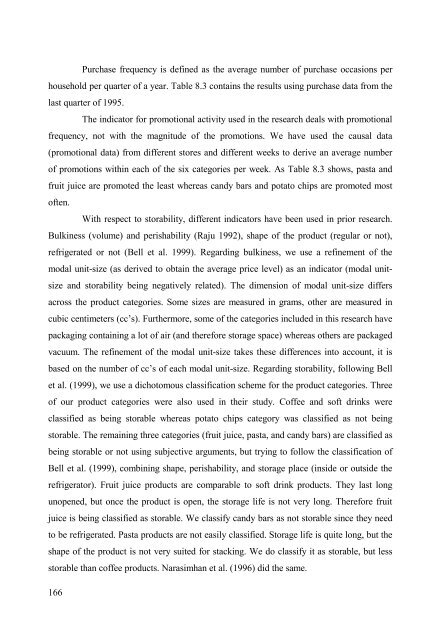Analysis of Sales Promotion Effects on Household Purchase Behavior
Analysis of Sales Promotion Effects on Household Purchase Behavior
Analysis of Sales Promotion Effects on Household Purchase Behavior
Create successful ePaper yourself
Turn your PDF publications into a flip-book with our unique Google optimized e-Paper software.
<strong>Purchase</strong> frequency is defined as the average number <str<strong>on</strong>g>of</str<strong>on</strong>g> purchase occasi<strong>on</strong>s per<br />
household per quarter <str<strong>on</strong>g>of</str<strong>on</strong>g> a year. Table 8.3 c<strong>on</strong>tains the results using purchase data from the<br />
last quarter <str<strong>on</strong>g>of</str<strong>on</strong>g> 1995.<br />
The indicator for promoti<strong>on</strong>al activity used in the research deals with promoti<strong>on</strong>al<br />
frequency, not with the magnitude <str<strong>on</strong>g>of</str<strong>on</strong>g> the promoti<strong>on</strong>s. We have used the causal data<br />
(promoti<strong>on</strong>al data) from different stores and different weeks to derive an average number<br />
<str<strong>on</strong>g>of</str<strong>on</strong>g> promoti<strong>on</strong>s within each <str<strong>on</strong>g>of</str<strong>on</strong>g> the six categories per week. As Table 8.3 shows, pasta and<br />
fruit juice are promoted the least whereas candy bars and potato chips are promoted most<br />
<str<strong>on</strong>g>of</str<strong>on</strong>g>ten.<br />
With respect to storability, different indicators have been used in prior research.<br />
Bulkiness (volume) and perishability (Raju 1992), shape <str<strong>on</strong>g>of</str<strong>on</strong>g> the product (regular or not),<br />
refrigerated or not (Bell et al. 1999). Regarding bulkiness, we use a refinement <str<strong>on</strong>g>of</str<strong>on</strong>g> the<br />
modal unit-size (as derived to obtain the average price level) as an indicator (modal unitsize<br />
and storability being negatively related). The dimensi<strong>on</strong> <str<strong>on</strong>g>of</str<strong>on</strong>g> modal unit-size differs<br />
across the product categories. Some sizes are measured in grams, other are measured in<br />
cubic centimeters (cc’s). Furthermore, some <str<strong>on</strong>g>of</str<strong>on</strong>g> the categories included in this research have<br />
packaging c<strong>on</strong>taining a lot <str<strong>on</strong>g>of</str<strong>on</strong>g> air (and therefore storage space) whereas others are packaged<br />
vacuum. The refinement <str<strong>on</strong>g>of</str<strong>on</strong>g> the modal unit-size takes these differences into account, it is<br />
based <strong>on</strong> the number <str<strong>on</strong>g>of</str<strong>on</strong>g> cc’s <str<strong>on</strong>g>of</str<strong>on</strong>g> each modal unit-size. Regarding storability, following Bell<br />
et al. (1999), we use a dichotomous classificati<strong>on</strong> scheme for the product categories. Three<br />
<str<strong>on</strong>g>of</str<strong>on</strong>g> our product categories were also used in their study. C<str<strong>on</strong>g>of</str<strong>on</strong>g>fee and s<str<strong>on</strong>g>of</str<strong>on</strong>g>t drinks were<br />
classified as being storable whereas potato chips category was classified as not being<br />
storable. The remaining three categories (fruit juice, pasta, and candy bars) are classified as<br />
being storable or not using subjective arguments, but trying to follow the classificati<strong>on</strong> <str<strong>on</strong>g>of</str<strong>on</strong>g><br />
Bell et al. (1999), combining shape, perishability, and storage place (inside or outside the<br />
refrigerator). Fruit juice products are comparable to s<str<strong>on</strong>g>of</str<strong>on</strong>g>t drink products. They last l<strong>on</strong>g<br />
unopened, but <strong>on</strong>ce the product is open, the storage life is not very l<strong>on</strong>g. Therefore fruit<br />
juice is being classified as storable. We classify candy bars as not storable since they need<br />
to be refrigerated. Pasta products are not easily classified. Storage life is quite l<strong>on</strong>g, but the<br />
shape <str<strong>on</strong>g>of</str<strong>on</strong>g> the product is not very suited for stacking. We do classify it as storable, but less<br />
storable than c<str<strong>on</strong>g>of</str<strong>on</strong>g>fee products. Narasimhan et al. (1996) did the same.<br />
166

















